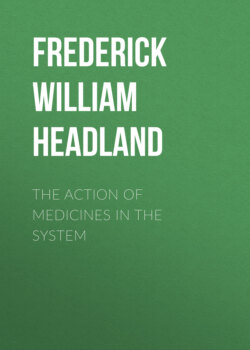Читать книгу The Action of Medicines in the System - Frederick William Headland - Страница 2
На сайте Литреса книга снята с продажи.
Table of Contents
ОглавлениеA CLASSIFICATION OF MEDICINES WHICH ACT AFTER ENTERING INTO THE BLOOD, ACCORDING TO THEIR SUPPOSED MODES OF OPERATION.
CHAPTER I.
INTRODUCTORY REMARKS.
CHAPTER II.
ON SOME OF THE MORE IMPORTANT CLASSIFICATIONS OF MEDICINES, AND OPINIONS OF AUTHORS RESPECTING THEIR ACTIONS.
CHAPTER III.
ON THE GENERAL MODES OF ACTION OF THERAPEUTIC AGENTS INTRODUCED INTO THE STOMACH.
Prop. I. — That the great majority of medicines must obtain entry into the blood, or internal fluids of the body, before their action can be manifested.
Prop. II. — That the great majority of medicines are capable of solution in the gastric or intestinal secretions, and pass without material change, by a process of absorption, through the coats of the stomach and intestines, to enter the capillaries of the Portal system of veins.
Prop. III. — That those medicines which are completely insoluble in water, and in the gastric and intestinal juices, cannot gain entrance into the circulation.
Prop. IV. — That some few remedial agents act locally on the mucous surface, either before absorption, or without being absorbed at all. That they are chiefly as follow: —
Prop. V. — That the medicine, when in the blood, must permeate the mass of the circulation, so far as may be required to reach the parts on which it tends to act.
Prop. VI. — That while in the blood, the medicine may undergo change, which in some cases may, in others may not, affect its influence. That these changes may be—
Prop. VII. — That a first class of medicines, called Hæmatics , act while in the blood, which they influence. That their action is permanent.
Prop. VIII. — That a second class of medicines, called Neurotics , act by passing from the blood to the nerves or nerve-centres, which they influence.
Prop. IX. — That a third class of medicines, called Astringents , act by passing from the blood to muscular fibre, which they excite to contraction.
Prop. X. — That a fourth class of medicines, called Eliminatives , act by passing out of the blood through the glands, which they excite to the performance of their functions .
CHAPTER IV.
GENERAL INDEX.
